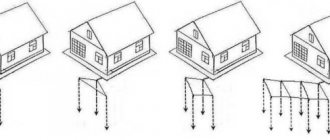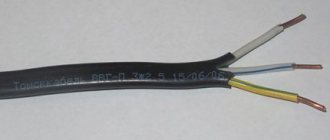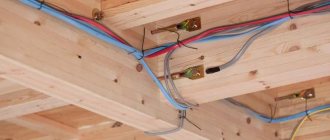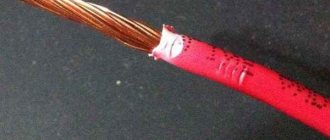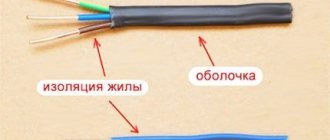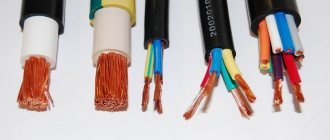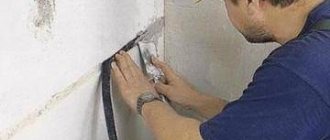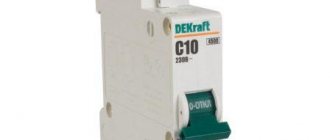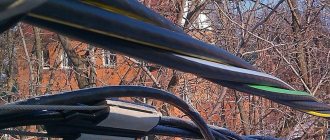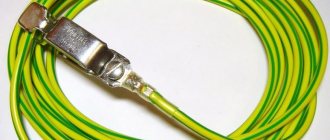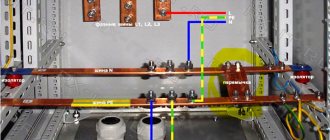At the very beginning of the renovation, you need to think about the wiring in the apartment - after all, this is one of the things that will be extremely difficult to redo after the renovation. If you go to the cables and wires section, you will see a huge variety that may scare you. In this article we will look at which cables and wires may be suitable directly for your wiring in an apartment or house.
Of all the variety, two types of cable are used for wiring - VVG and NYM. Before we look at the criteria for this cable, I would like to immediately note that, first of all, the choice of power cable is a safety issue.
That is, when talking about cables, we are primarily talking about risks - if you buy a cheap cable for wiring, this does not mean that you will have a fire, just that the likelihood of a fire is higher. If you take a high-quality and expensive cable, the probability tends to zero. The same applies to the cable cross-section - you can take and choose a cross-section smaller than the recommended one and the risks will increase (but this does not mean that a fire will certainly happen), or you can take a cable with a large margin, which will significantly reduce the likelihood of a fire. So, what criteria do you need to decide on:
Difference between VVG or NYM
What is the difference between VVG and NUM? These cables differ: - color
(VVG cable is black, and NYM cable is gray)
- shape
(VVG, can be flat and round, NUM is always round)
- operating temperature
(VVG from -50 to +50, NUM from -30 to +40)
- shell material
(VVG - PVC, NUM - polyvinyl chloride)
- presence of filler
(in the standard version, VVG does not have filler, but NYM always has it)
- reaction to direct sunlight
(VVG is more stable, NUM is less stable)
KG – designed for harsh conditions
Perhaps the best solution for outdoor use is a cable marked KG. It has an insulating layer of rubber based on natural rubber. Moreover, such insulation is used both outside and for the cores themselves. This helps the product maintain high flexibility even in severe frost, and also makes it resistant to ultraviolet radiation - the shell does not crack. Withstands high air humidity. It is suitable for outdoor lighting of cottages, private houses, and enterprises. Can be used in car washes and production areas. It is often the basis for creating extension cords and powering equipment.
Understanding the labeling
Cable cross-section
The cable cross-section must be selected primarily for specific tasks.
Below is a table of the relationship between power and cross-section, while it is worth taking into account the fact that for closed wiring the cross-section reserve should be 20-30 percent. The advice for selecting the cross-section for the cable is simple: - CABLE FOR SOCKETS - SECTION 2.5 SQ.MM.
— CABLE FOR LIGHT — CROSS SECTION 1.5 SQ.MM. — CABLE FOR PLATE — 4 SQ.MM.
Which wires are not suitable?
Conducting electrical wiring in an apartment not with a cable, but with a wire, even multi-core or double-insulated, is not a good idea. They are highly flammable with prolonged use. The wires do not meet the requirements of the PUE for residential buildings. Therefore, if there is a choice and opportunity, then when asked which wire to use for wiring, you need to answer that a cable is used.
PVS wire
Extension cords are made from it and household electrical appliances are connected to home wiring. The work is carried out up to 380 V, the number of conductors is 2, the cross-section of the stranded core is 0.75-10 mm². Copper conductor wrapped in vinyl materials is used.
Wiring is of low quality. The cost is low, but it is offset by the increased price of work:
- the connecting ends must be tinned and soldered;
- has an increased risk of fire due to the stranded core;
- does not imply their presence in 1 device.
Wires and cords ShVVP, PVVP
Copper conductors, single- and multi-wire. Connect household electrical appliances. There is no non-combustible insulation. Service life is short. Not used for fixed wiring.
Choose a GOST or TU cable?
In a separate article, we looked at the differences between GOST and TU cables. In short, any cable is manufactured according to the technical specifications of the plant (abbreviated as TU). This means that the manufacturer declares certain conditions that the cable meets (resistance per 1 km of cable, sheath and insulation materials, filler, type of metal, etc.). At the same time, each plant has the opportunity to obtain compliance of its plant’s specifications with the state standard (abbreviated GOST). If a plant receives GOST for its products, this means that the cable production plant’s specifications comply with the GOST standard. In common people, the cable that does not pass certification is called TU (because the cable complies with the Technical Conditions of the plant, but does not comply with GOST), and the cable that has passed certification is called GOST (that is, the plant’s specifications comply with GOST). Very often we are asked the question - what to take, GOST or TU? This decision remains primarily yours. We, for our part, believe that the optimal cable in terms of quality-price ratio is the VVGng GOST cable - that is, a flat cable without filler, but made in accordance with GOST. It is more than enough for household needs.
Review of stamps in flat and round versions
Manufacturers produce a large number of electrical cable products in round and flat designs. All of them perform different functions and are used for different installation methods, operating conditions, power and types of consumers. Let's briefly look at some of them.
Round cables
NYMng(A)-LS
is a round power cable with copper conductors and non-flammable PVC insulation. Under the general shell of reduced fire hazard, it has a filling made of unvulcanized rubber. Designed for transmitting electrical energy to stationary installations in networks with alternating voltage up to 0.66 kV. The cable is made according to German technology and standards, does not spread fire when laid in groups and has reduced smoke and gas emissions (Low smoke).
AVVG
– a power cable in a round design, which has current-carrying conductors made of aluminum, and insulation and sheath made of polyvinyl chloride. It is used for transmitting electrical energy in networks with voltages of 0.66 and 1 kV and connecting stationary consumers for domestic or industrial purposes. It can be laid without restrictions on the difference in levels of cable routes, as well as in vertical sections.
VBBShv
– round armored power cable, which has copper conductors and polyvinyl chloride insulation. The cable armor is made of galvanized steel strips and does not have a cushion (under the armor). The general insulation is made from extruded protective hose. It is used in networks up to 1 kV for connecting stationary electrical installations without restrictions on the level difference along the laying route.
Flat cables
SHVVP
– a flat flexible cord with a copper or tinned copper core with insulation and a PVC sheath. This product is used in 220/380V networks for connecting lamps, low-power household appliances and radio equipment, as well as making extension cords for residential buildings.
PPV
– a flat wire that has separating jumpers between the cores. It does not have general insulation for the conductors and can be used with either copper conductors (PPV) or aluminum conductors (APPV). It is used in aggressive chemical environments with alternating voltage up to 450V and frequency up to 400 Hz. In networks with constant voltage, up to 1 kV is used. Installed in pipes and ducts and not suitable for flexible installation.
VVGng-LS-P
– flat cable with copper conductors and non-flammable PVC insulation and sheath. Has reduced smoke and gas emissions. It is used for transmitting electrical energy and connecting fixed electrical installations in networks with a voltage of 0.66 - 1 kV.
Features of VVGng installation
- Hidden gasket. The advantage of this type is to minimize mechanical damage to the cable and ensure a neat appearance. The installation is carried out inside building structures, in existing niches, in prepared recesses in the walls (grooves), in a concrete screed on the floor and under interior facing elements. An exception among building materials is installation in wooden walls. In such cases, additional protection is required in the form of metal hoses or pipes made of non-combustible materials. When installing VVGng hidden, it is important to use cable products from reliable manufacturers, since replacement will cause difficulties with repairs.
- Outdoor installation. Due to its high resistance to environmental influences, it is possible to lay VVGng cable in an open manner. Wiring is permitted on brick, concrete and other types of hard surfaces, with non-flammable or difficult to combustible coating. When laying on wooden surfaces, it is necessary to use metal hoses, plastic corrugation, metal and plastic pipes. If it is necessary to travel by air, the cable can be suspended on strings or cables while providing protection from excessive sagging and mechanical damage.
- Gasket on trays and boxes. Technical requirements allow the installation of VVGng in cable racks, galleries, specialized trays and boxes. Trays are open structures, and boxes are closed. They are attached to walls or ceilings. The installation height of trays and boxes must be at least 2 m from the floor level. However, if the room is intended for personnel who have undergone appropriate training, then the height is not standardized. VVGng is allowed for group laying. The maximum number of cables on a tray depends on the cross-section of the conductor and the width of the tray. When laying in rows, it is necessary to maintain a clear distance of 5 mm; in other cases, this distance increases four times.
- Installation in the ground. The laying of VVGng underground must be carried out with additional protection (pipes, tunnels), since there is no armor in its design. The PUE stipulates that unarmored cables must be resistant to mechanical stress during installation and repair work. To protect VVGng, double-walled corrugated pipes and technical polyethylene pipes are most often used. Steel pipes are prohibited for outdoor installation.
Replacing wiring in an apartment
How to reliably replace wiring in an apartment.
Wiring hidden in the wall, which cable is better - flat or round. Masters online: 156 Orders per week: 2,148 Offers per day: 901
flat copper 3x2.5 or 2.x2.5 if there is no grounding or it is not needed
VVGng 3x1.5 for lighting VVGng 3x2.5 for sockets
Call a competent team. The shape of the cable does not matter, the main thing is its type.
Leave it to a professional. Cable - copper - 1.5mm - light, 2.5mm - sockets. Flat or round does not matter. The brand and cross-section are important
The old cable needs to be cut and a new light of the same section must be installed. other sockets round flat does not matter, preferably copper
It doesn't matter whether the cable is flat or round. It is important to choose the right sections: for sockets 3*2.5, for light 3*1.5. Usually they buy cable brands VVGng (sometimes with the prefix ls), and NYM. VVG - flat, NYM - round. Keep in mind that VVGng 3*2.5 fits very poorly into 16mm corrugation. And 3*1.5 works great. NYM is in the 16th corrugation. Moreover, half of the practicing electricians believe that stretching NYM in corrugation is reinsurance. Regarding cable manufacturers: NYM buys the production of a well-promoted or Bryansk plant (it is cheaper, but not inferior in quality to Sevkabel). VVG -, Kaluga and Oryol plants.
Thank you, where is the best place to buy a non-counterfeit cable in Moscow?
In residential premises and public buildings VVG ng ls, NYM - for wooden buildings, PUNP - prohibited.
Wiring should be done using NYM 3X2.5 and 3X1.5 cable. Divide into groups: for each room there is a group for sockets and a group for lighting. Each group is protected by an individual circuit breaker (16A sockets, 6-10 A light) Groups in wet rooms and kitchens are additionally protected by an RCD. For washing machine, dishwasher, boiler, etc. It is advisable to install an individual cable and install your own machine. For a hob (or electric stove), install a cable with a cross-section of at least 4 sq. mm (if the network is single-phase) and a 32A circuit breaker. The wire connections are made very well (welding is the most reliable) But high-quality twists and terminal blocks are also allowed. In general, it is dangerous to trust this work to just anyone and the cost is not cheap.
VVGNG or NUM cable in the wall
To lay new wiring, you need to make lowerings for each socket and switch. Then you must decide on the ceiling, if all the ceilings are suspended, then all the wiring and distribution boxes can be run along the rough ceiling. If the ceiling remains zero, then you need to prepare for more grooves. Cable of any shape 3x2.5 to 3x1.5 sockets for light and of course don’t forget about the input cable, it will most likely also need to be replaced
I beg your pardon, but when in 3-5 years you get tired of the suspended suspended ceilings and want to drop them, change the wiring again to hide the junction boxes and cable?
Yes, and the old wiring remains in the wall; it is not necessary to remove it if you completely turn off the power
Hello Natalya, I’m reading this and couldn’t resist commenting. The question is as meaningless as most of the answers. Electrical wiring can be reliably replaced by a Master with a capital letter, who will know and love his work, and then the questions “which cable is better” simply will not arise. It so happened that electricians were and will be done by ignoramuses, because for access to the Master you have to pay twice and expensively. IMHO.
Yes, they are all just having fun here))) Some simply amaze with ignorance and lack of knowledge. Well, I would respectfully advise the hostess to focus on choosing a MASTER, and not on technical subtleties. Don't mind your own business! ))) No offense.
Natalya, only an excellent electrician can reliably replace the wiring. He will also help with the choice of materials. General requirements: cable - NYM or VVGng LS GOST. 3x1.5 (lighting) 3x2.5 (sockets) 3x4 (oven, hob), 3x6 (input), flat round doesn’t matter (I use flat, it’s easier to put in grooves); machines 6-10A (lighting), 16A (sockets), additionally for RCD sockets (differential circuit breakers), for s/u differential circuit breakers with a leakage current of 10 mlA, manufacturers: Schneider, Legrand, ABB, Siemens (choose according to your budget, but do not save much - this is your safety!!), it is advisable to make connections by twisting + welding in junction boxes installed on the walls (must be accessible for maintenance) And another tip: before installing in the kitchen, it is advisable to call a designer and draw up a project for the future set, otherwise It’s almost impossible to guess the position of the sockets, and in general, start by arranging the furniture on paper, this will make it easier to decide what and where. Good luck with the repair
Pyryshev Dmitry Mikhailovich - competent approach! +1
Thank you, reputation is more important than anything.
so as not to spend a lot of money on installers and materials, throw the main cable to the boxes in each room with a 4x4 cable (light phase, socket phase, zero, ground) or 3x4 if there is no grounding, and then throw everything with the usual 3x2.5 and 2x1.5 ( the earth is not needed for the world; all this is profanation).
What should you be wary of when purchasing?
There are two pitfalls that can be easily stumbled upon due to inexperience:
- Purchasing a cable without markings on the protective sheath. Under this guise, you can sell any wire, even those prohibited for installation in residential premises. If you buy an unmarked wire and subsequently have a fire, the insurance company will not pay compensation because cables that are prohibited for use in wiring will be found on site;
- Purchasing cable from unscrupulous manufacturers who save money by reducing the cross-section and thickness of the protective sheath. It looks difficult to spot the trick. But imagine what will happen if you calculated the power in the electrical network, calculated the required conductor cross-section, and installed a wire of a smaller cross-section? The wiring will heat up and a fire may occur. And the insulating shell is so thin that it can easily burn through or simply deteriorate, exposing the wires.
15% of fires occur due to the installation of wires that do not meet safety standards. Poor quality wiring is installed out of ignorance or in a desire to reduce the cost of electrical work. But they forget that human life is more valuable. Don’t skimp on purchasing cables to protect your family and get high-quality wiring that won’t require repairs for decades.
